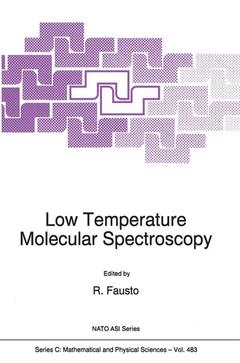Description
Low Temperature Molecular Spectroscopy, 1996
Nato Science Series C: Series, Vol. 483
Coordinator: Fausto Rui
Language: English
Subjects for Low Temperature Molecular Spectroscopy:
Keywords
Atom; Base; Conformational isomerism; Isomer; Neutron; experiment; isomerism; tautomer
Publication date: 10-2011
640 p. · 16x24 cm · Paperback
640 p. · 16x24 cm · Paperback
Description
/li>Contents
/li>Comment
/li>
Molecular spectroscopy has achieved rapid and significant progress in recent years, the low temperature techniques in particular having proved very useful for the study of reactive species, phase transitions, molecular clusters and crystals, superconductors and semiconductors, biochemical systems, astrophysical problems, etc. The widening range of applications has been accompanied by significant improvements in experimental methods, and low temperature molecular spectroscopy has been revealed as the best technique, in many cases, to establish the connection between experiment and theoretical calculations. This, in turn, has led to a rapidly increasing ability to predict molecular spectroscopic properties.
The combination of an advanced tutorial standpoint with an emphasis on recent advances and new perspectives in both experimental and theoretical molecular spectroscopy contained in this book offers the reader insight into a wide range of techniques, particular emphasis being given to supersonic jet and matrix isolation techniques, spectroscopy in cryogenic solutions (including liquid noble gases), and in both crystalline and amorphous states. Suitable quantum chemical methods are also considered, as are empirically based force field methods for calculating spectra of large molecular systems.
The wide range of topics covered includes: molecular dynamics and reactivity, time-resolved and high-resolution spectroscopy, conformational analysis, hydrogen bonding and solvent effects, structure and dynamics of weakly bound complexes, transition metal and organic photochemistry, spectroscopy of excited states, ab initio prediction of molecular spectra, and biochemical and astrophysical applications.
The combination of an advanced tutorial standpoint with an emphasis on recent advances and new perspectives in both experimental and theoretical molecular spectroscopy contained in this book offers the reader insight into a wide range of techniques, particular emphasis being given to supersonic jet and matrix isolation techniques, spectroscopy in cryogenic solutions (including liquid noble gases), and in both crystalline and amorphous states. Suitable quantum chemical methods are also considered, as are empirically based force field methods for calculating spectra of large molecular systems.
The wide range of topics covered includes: molecular dynamics and reactivity, time-resolved and high-resolution spectroscopy, conformational analysis, hydrogen bonding and solvent effects, structure and dynamics of weakly bound complexes, transition metal and organic photochemistry, spectroscopy of excited states, ab initio prediction of molecular spectra, and biochemical and astrophysical applications.
Preface. Spectroscopy of Matrix Isolated Molecules. 1. Principles, Procedures and Pitfalls; A.J. Downs. Spectroscopy of Matrix Isolated Molecules. 2. Applications: Pointing the Way to Synthesis and Mechanisms in Inorganic and Organometallic Chemistry; A.J. Downs. Matrix Photochemistry of Transition Metal Complexes: Principles, Applications and Links to Other Methods; R.N. Perutz. Conformational Isomerism and Photodecomposition of Carboxylic Compounds Studied by Matrix Isolation Infrared Spectroscopy; R. Fausto. Combined Matrix-Isolation FT-IR and ab initio 6-31++G** Studies on the Tautomerism and H- Bonding Properties of Nucleic Acid Bases and Simpler Model Molecules; G.H. Maes, et al. Low Temperature Spectroscopy: From Ground to Space. The Case of the Diffuse Interstellar Bands; F. Salama. Association Between Electron Donor Molecules and HCl in Argon Matrices; W.O. George, D.A. Williams. Matrix Perturbation of Vibrational Isotope Effects; R.L. Redington. Heavy Atom Effects in Proton Tunneling Phenomena; R.L. Redington. The Cooling of Internal Degrees of Freedom of Polyatomic Molecules in Supersonic Free Jets; R. Jost. Pulsed Nozzle Fourier Transform Microwave Spectroscopy of Weakly Bound Molecular Complexes; A. Bauder. Structure and Dynamics of Van der Waals Complexes; A. Bauder. Large Amplitude Vibrations in Electronic Spectra in Supersonic Jets; J.M. Hollas. Conformational Analysis by Laser Spectroscopy; D.W. Pratt. Infrared Spectroscopy in Liquefied Noble Gases; B.J. Van der Veken. Tunneling Spectroscopy with Neutrons: Quantised Rotational States in Solids; J. Tomkinson. The Symmetry of Molecules and Molecular Vibrations; B. Schrader. Phonon Modes of Molecular Crystals; D.T. Durig, J.R. Durig. Spectra of Plastic and Disordered Crystals; J.R. Durig, D.T. Durig. Conformational Studies by Vibrational Spectroscopy Under High Pressure; P. Klaeboe. NIR FT Raman Spectroscopy: Finding the Optimal Conditions to Record Spectra of Living Systems; B. Schrader. Using Low Temperature Spectroscopy to Understand Protein Structure, Dynamics and Function; P.R. Carey. Reflection Absorption Infrared Spectroscopy at Low Temperatures; W.A. Brown, P. Gardner. Author Index. Subject Index.
The combination of an advanced tutorial standpoint with an emphasis on recent advances and new perspectives in both experimental and theoretical molecular spectroscopy contained in this book offers the reader insight into a wide range of techniques, particular emphasis being given to supersonic jet and matrix isolation techniques, spectroscopy in cryogenic solutions (including liquid noble gases), and in both crystalline and amorphous states. Suitable quantum chemical methods are also considered, as are empirically based force field methods for calculating spectra of large molecular systems.
© 2024 LAVOISIER S.A.S.




